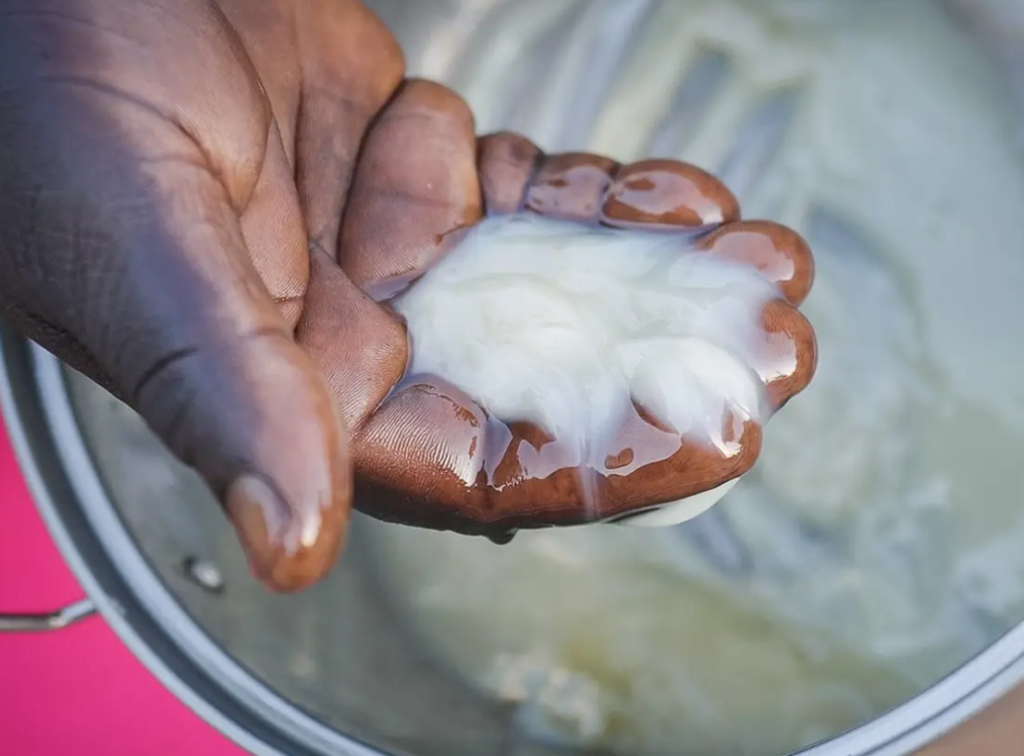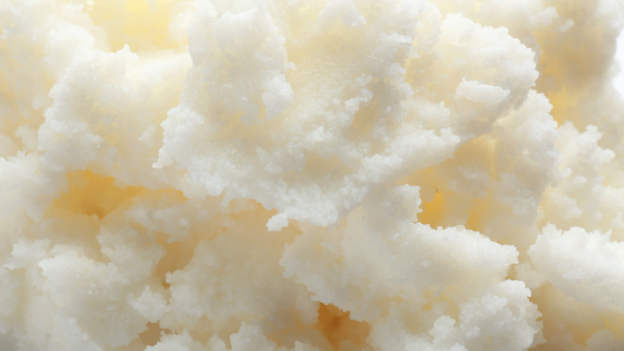You are probably already familiar with shea butter. Its moisturizing and soothing qualities make it a favorite in many balms and lotions. However, you may not be aware that shea butter has a cousin! A different species of tree, native to East Africa, supplies us with incredibly luxurious, unctuous, semi-liquid Nilotica shea butter. Which one do you use, and what are the benefits/downfalls of using a different shea? There are several factors to keep in mind. Let’s examine regular, West African shea butter first as that is the variety familiar to most people.
West African shea butter is obtained from the Vitellaria paradoxa tree. It’s abundant, affordable, and can be found in odorless / colorless organic quality. The butter is naturally rich in a fatty material called stearic acid, which is a hardening agent sometimes used in creams. West African shea has 35-45% stearic acid and it’s more solid, almost pasty, compared to Nilotica shea butter (which only has 25-35% of stearic acid). This fatty acid composition means that West African shea is useful in formulas that need a structure, such as balms and salves, or thicker creams. West African shea also has a proven track record in cosmetics and is a dependable ingredient. You can buy it from a very large number of vendors.
However, the firmer texture of West African shea means that it has a waxier texture. For smooth ointments or light lotions, it may not absorb fast enough. This texture is partially due to lower amounts of oleic acid, an unsaturated fatty acid. This decreased oleic acid content makes West African shea less moisturizing overall. However, if the texture works for the style product you’re designing, it’s hard to go wrong with West African shea. By buying the refined version (usually molten shea is poured through charcoal, or a similar process) you can remove the natural but somewhat unpleasant “earthy” aroma of fresh shea butter and also remove a lot of the color.

So, what about the competition? Nilotica shea butter comes from the Vitellaria nilotica tree and is native to East Africa. It is a much less developed industry than West African shea butter, often providing income to family businesses who harvest the Nilotica largely by hand. Primarily found in Uganda and Sudan, this butter has exceptional moisturizing properties due to its chemical composition. Nilotica shea butter has a higher percentage of oleic acid (50-60%) compared to West African shea butter (40-55%). This oleic fatty acid is well-known for its moisturizing properties. It can bring softness and increased hydration to the skin. Also, Nilotica shea butter has a creamier, softer texture, almost liquid. This makes it easier to incorporate into light lotions and body butters where we might want faster absorption. West African shea is pasty and can be hard to “rub into” the skin. Nilotica applies smoothly and absorbs faster, making it particularly suitable for products like body butters, light lotions, and hair conditioners.
This more-favorable texture does not diminish the nutrition that Nilotica offers the skin. It’s high in Vitamin A, which can help with skin elasticity and has natural antioxidants in the form of Vitamin E. This helps to prevent oxidative damage to the skin and results in overall improved skin health. However, due to its limited production (the shea tree only fruits once per year), it can be harder to source and a little more expensive than West African shea butter. It’s also not a direct 1:1 replacement for West African shea. The texture will be different, so if you are counting on shea to have a higher melting point and lend rigidity to a balm, Nilotica will need some help achieving that stiffness – maybe some wax, to add to the body.
Nilotica offers a more pleasant application and “skin feel”. Sometimes all you have to do is see something once to understand it. Insider Business (no affiliation) has a fantastic Youtube video showing the Nilotica harvesting process, and you can see the appeal of this East African gem for yourself.
https://www.youtube.com/watch?v=DxmgJQArYGg&t=455s&ab_channel=InsiderBusiness
Consider incorporating Nilotica or West African shea butter it into your next balm or lotion!

